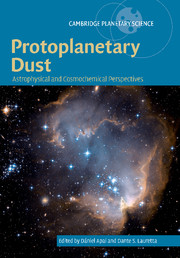Book contents
- Frontmatter
- Contents
- List of contributing authors
- Preface
- Acknowledgments
- 1 Planet formation and protoplanetary dust
- 2 The origins of protoplanetary dust and the formation of accretion disks
- 3 Evolution of protoplanetary disk structures
- 4 Chemical and isotopic evolution of the solar nebula and protoplanetary disks
- 5 Laboratory studies of simple dust analogs in astrophysical environments
- 6 Dust composition in protoplanetary disks
- 7 Dust particle size evolution
- 8 Thermal processing in protoplanetary nebulae
- 9 The clearing of protoplanetary disks and of the proto-solar nebula
- 10 Accretion of planetesimals and the formation of rocky planets
- Appendix 1 Common minerals in the Solar System
- Appendix 2 Mass spectrometry
- Appendix 3 Basics of light absorption and scattering theory
- Glossary
- Index
2 - The origins of protoplanetary dust and the formation of accretion disks
Published online by Cambridge University Press: 24 February 2010
- Frontmatter
- Contents
- List of contributing authors
- Preface
- Acknowledgments
- 1 Planet formation and protoplanetary dust
- 2 The origins of protoplanetary dust and the formation of accretion disks
- 3 Evolution of protoplanetary disk structures
- 4 Chemical and isotopic evolution of the solar nebula and protoplanetary disks
- 5 Laboratory studies of simple dust analogs in astrophysical environments
- 6 Dust composition in protoplanetary disks
- 7 Dust particle size evolution
- 8 Thermal processing in protoplanetary nebulae
- 9 The clearing of protoplanetary disks and of the proto-solar nebula
- 10 Accretion of planetesimals and the formation of rocky planets
- Appendix 1 Common minerals in the Solar System
- Appendix 2 Mass spectrometry
- Appendix 3 Basics of light absorption and scattering theory
- Glossary
- Index
Summary
Abstract Dust is an important constituent in the Universe. About 1% of the mass of the interstellar matter is in dust. This dust is either stardust that condensed in the winds of evolved stars and in the ejecta of supernova and nova explosions or dust that formed in dense interstellar clouds. Here, we will discuss the cycle of matter from stars to the interstellar medium and how interstellar clouds evolve to protostars and protostellar disks. We will discuss the nature and origin of interstellar dust and how it entered the Solar System. A small fraction of the stardust grains survived the earliest stages of Solar System formation and can be recognized by highly anomalous isotopic compositions as presolar grains in meteorites, interplanetary dust particles, and cometary matter, with concentrations at the subpermil level. Imprints of likely interstellar chemistry are seen as D and 15N enrichments in organic matter in primitive Solar System materials.
Dust is an important constituent in the Universe and its meaning for astrophysics is manifold. In the interstellar medium (ISM) about 1% of the mass is in dust. A major fraction of the refractory elements in the ISM is locked up in dust leading to a depletion of these elements in the gas phase. Dust is responsible for interstellar extinction (absorption and scattering of light). It was this feature that led to the first firm identification of dust in the ISM in the twentieth century. Detailed studies of interstellar extinction imply the presence of solid particles with sizes of the wavelength of visible light, i.e. in the submicrometer range.
- Type
- Chapter
- Information
- Protoplanetary DustAstrophysical and Cosmochemical Perspectives, pp. 27 - 65Publisher: Cambridge University PressPrint publication year: 2010
- 5
- Cited by

